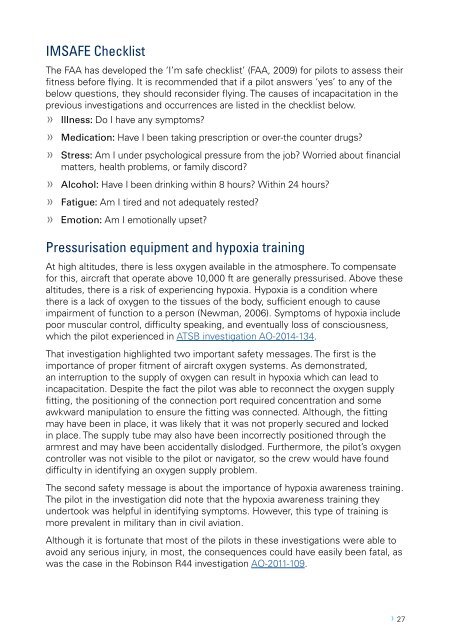Pilot incapacitation occurrences 2010–2014
8rKXy6YKY
8rKXy6YKY
Create successful ePaper yourself
Turn your PDF publications into a flip-book with our unique Google optimized e-Paper software.
IMSAFE Checklist<br />
The FAA has developed the ‘I’m safe checklist’ (FAA, 2009) for pilots to assess their<br />
fitness before flying. It is recommended that if a pilot answers ‘yes’ to any of the<br />
below questions, they should reconsider flying. The causes of <strong>incapacitation</strong> in the<br />
previous investigations and <strong>occurrences</strong> are listed in the checklist below.<br />
»»<br />
Illness: Do I have any symptoms?<br />
»»<br />
Medication: Have I been taking prescription or over-the counter drugs?<br />
»»<br />
Stress: Am I under psychological pressure from the job? Worried about financial<br />
matters, health problems, or family discord?<br />
»»<br />
Alcohol: Have I been drinking within 8 hours? Within 24 hours?<br />
»»<br />
Fatigue: Am I tired and not adequately rested?<br />
»»<br />
Emotion: Am I emotionally upset?<br />
Pressurisation equipment and hypoxia training<br />
At high altitudes, there is less oxygen available in the atmosphere. To compensate<br />
for this, aircraft that operate above 10,000 ft are generally pressurised. Above these<br />
altitudes, there is a risk of experiencing hypoxia. Hypoxia is a condition where<br />
there is a lack of oxygen to the tissues of the body, sufficient enough to cause<br />
impairment of function to a person (Newman, 2006). Symptoms of hypoxia include<br />
poor muscular control, difficulty speaking, and eventually loss of consciousness,<br />
which the pilot experienced in ATSB investigation AO-2014-134.<br />
That investigation highlighted two important safety messages. The first is the<br />
importance of proper fitment of aircraft oxygen systems. As demonstrated,<br />
an interruption to the supply of oxygen can result in hypoxia which can lead to<br />
<strong>incapacitation</strong>. Despite the fact the pilot was able to reconnect the oxygen supply<br />
fitting, the positioning of the connection port required concentration and some<br />
awkward manipulation to ensure the fitting was connected. Although, the fitting<br />
may have been in place, it was likely that it was not properly secured and locked<br />
in place. The supply tube may also have been incorrectly positioned through the<br />
armrest and may have been accidentally dislodged. Furthermore, the pilot’s oxygen<br />
controller was not visible to the pilot or navigator, so the crew would have found<br />
difficulty in identifying an oxygen supply problem.<br />
The second safety message is about the importance of hypoxia awareness training.<br />
The pilot in the investigation did note that the hypoxia awareness training they<br />
undertook was helpful in identifying symptoms. However, this type of training is<br />
more prevalent in military than in civil aviation.<br />
Although it is fortunate that most of the pilots in these investigations were able to<br />
avoid any serious injury, in most, the consequences could have easily been fatal, as<br />
was the case in the Robinson R44 investigation AO-2011-109.<br />
› 27


